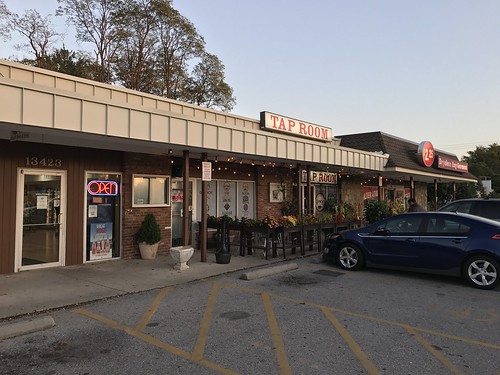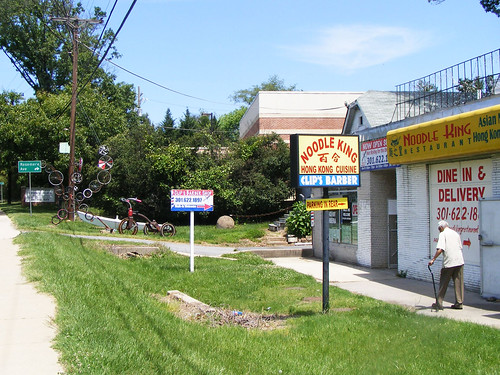Suburban strip malls aren't known for their ambiance. As shoppers seek out unique experiences or just take their business online, these places could be in deep trouble. In Montgomery County, a new study aims to prepare suburban shopping districts for the future of retail.
Lately I’ve been buying my booze at this place called Quench!, which has an amazing selection of craft beer from little companies like Evil Twin and Stillwater that can be hard to find. In the back is a deli with amazing sandwiches, and once a week, a local bakery called Upper Crust sets up in one of the aisles to sell bread. Next door, there's a tap room, with a little patio shrouded in ivy and string lights.
You probably expect me to tell you this place is in Shaw, or in a new "town center"-style development like the Mosaic District. In fact, Quench! sits in a grungy, half-vacant 1960s strip mall far out New Hampshire Avenue in eastern Montgomery County, a stretch of road with so many sprawling megachurches that it's called the "Highway to Heaven." It might just hold some secrets to the future of retail — and suburbia.
Montgomery County's issue isn't vacancies, but reputation
Retail trends are changing as more shoppers buy things online, but also as the kinds of stores they patronize have changed. Stores that can’t adapt — especially big chain stores — have been struggling, and many suburban communities are dealing with massive vacancies and abandonment.
Here in the DC area, a number of enclosed shopping malls have been torn down, including White Flint Mall in Montgomery County. However, vacancies aren't a huge problem in much of Montgomery County, according to a recent study of local retail the Planning Department did with help from Streetsense, a Bethesda-based consulting firm.
The study found that the county’s retail market is pretty healthy, in part because we avoided the mistake of many other suburban places that built too much retail space. One exception was Gaithersburg, where Lakeforest Mall has been losing customers and retailers (though the mall could get a second life by embracing the area's international community, as I wrote in Washingtonian).
However, the county's retail environment does suffer from the perception that it's difficult to open a business, particularly if you're seeking a liquor license. Denizens Brewing Company, a brewery in downtown Silver Spring, had to have a state law changed so it could open. Another Silver Spring brewery, Parallel World, needed to have the zoning laws adjusted before it could even get a business loan. The study recommended that the county improve the permitting process for restaurants and bars as well as for companies that make their own products.
Another issue the study raised is that retailers have long avoided the less affluent eastern side of the county because of an assumption that customers don't have money to spend. The result is that residents often have to travel to the more affluent western side of the county to shop or even to eat at a nice restaurant. While the study didn't totally address this issue, there is a pretty interesting opportunity in East County to create the kind of authentic, locally-focused retail experience that shoppers increasingly want.
East County's retail districts have a big opportunity
Even as shopping malls and high-end retail flocked to wealthy areas like Bethesda and Rockville, many of East County's commercial districts remained pretty small. Colesville, where Quench! is located, hasn't seen any major development in over 30 years, and you can still see parts of the rural crossroads it used to be. That’s due to a mix of careful planning (much of the area was zoned for low density suburban development) and neglect (some sections of East County didn’t have electricity or running water until the 1960s).
This isolation can be a strength, however. As people increasingly seek walkable neighborhoods with a strong sense of place, these places offer a sense of authentic community that can be difficult to find in suburban areas. As Rockville Pike boomed, many of its historic villages have largely disappeared, places like Windham, Edmonston, and Autrey Park. Meanwhile East County areas like Colesville, Ashton, and Burtonsville have retained their identity and their status as local commercial hubs.
Today, these “villages” are small enough to get around by foot or bike — Colesville is barely three miles across — but big enough to support some local bus service. Because retail space is cheap, there’s lots of cool stuff that neighbors could theoretically walk to: Quench!; Burtonsville's "Restaurant Row," featuring everything from Ethiopian to Afghan to Cuban food; corner grocery stores, and hardware stores.
These are the kind of businesses that, not long ago, you’d have to live inside the Beltway if you wanted to walk to them. However, many neighborhoods within DC and inside the Beltway have become very expensive because so many people want those things, yet neighbors often fight attempts to build more housing in those communities. These village centers in East County could offer an alternative for the large segment of homebuyers who want that that mix of suburban space and urban access, but at a far lower cost.
Montgomery County's older suburbs need more connections
That said, Colesville isn't an stand-in for downtown Silver Spring. East County's commercial districts consist of strip malls of varying sizes. There aren't many sidewalks or bike lanes, and the roads can be huge and fast. These communities are still far from the region’s jobs and activity centers, meaning many residents commute long distances to work.
It won't be that way forever though. Montgomery County’s bicycle plan will create more sidewalks and bike lanes, and the county will soon start work on a Bus Rapid Transit line that will connect East County to the Red Line. Meanwhile, the Viva White Oak development will give East County a downtown, with shops, offices, and homes all within walking distance of each other. Put together, these projects will help attract a new generation of people to older East County neighborhoods that need them.
Until that happens, places like Quench! suggest that there’s a different path forward for East County — one that takes advantage of its built history while adapting it for the future.
 |
| Quench! is a craft beer shop and restaurant in an unlikely place. |
You probably expect me to tell you this place is in Shaw, or in a new "town center"-style development like the Mosaic District. In fact, Quench! sits in a grungy, half-vacant 1960s strip mall far out New Hampshire Avenue in eastern Montgomery County, a stretch of road with so many sprawling megachurches that it's called the "Highway to Heaven." It might just hold some secrets to the future of retail — and suburbia.
Montgomery County's issue isn't vacancies, but reputation
Retail trends are changing as more shoppers buy things online, but also as the kinds of stores they patronize have changed. Stores that can’t adapt — especially big chain stores — have been struggling, and many suburban communities are dealing with massive vacancies and abandonment.
Here in the DC area, a number of enclosed shopping malls have been torn down, including White Flint Mall in Montgomery County. However, vacancies aren't a huge problem in much of Montgomery County, according to a recent study of local retail the Planning Department did with help from Streetsense, a Bethesda-based consulting firm.
The study found that the county’s retail market is pretty healthy, in part because we avoided the mistake of many other suburban places that built too much retail space. One exception was Gaithersburg, where Lakeforest Mall has been losing customers and retailers (though the mall could get a second life by embracing the area's international community, as I wrote in Washingtonian).
However, the county's retail environment does suffer from the perception that it's difficult to open a business, particularly if you're seeking a liquor license. Denizens Brewing Company, a brewery in downtown Silver Spring, had to have a state law changed so it could open. Another Silver Spring brewery, Parallel World, needed to have the zoning laws adjusted before it could even get a business loan. The study recommended that the county improve the permitting process for restaurants and bars as well as for companies that make their own products.
Another issue the study raised is that retailers have long avoided the less affluent eastern side of the county because of an assumption that customers don't have money to spend. The result is that residents often have to travel to the more affluent western side of the county to shop or even to eat at a nice restaurant. While the study didn't totally address this issue, there is a pretty interesting opportunity in East County to create the kind of authentic, locally-focused retail experience that shoppers increasingly want.
East County's retail districts have a big opportunity
Even as shopping malls and high-end retail flocked to wealthy areas like Bethesda and Rockville, many of East County's commercial districts remained pretty small. Colesville, where Quench! is located, hasn't seen any major development in over 30 years, and you can still see parts of the rural crossroads it used to be. That’s due to a mix of careful planning (much of the area was zoned for low density suburban development) and neglect (some sections of East County didn’t have electricity or running water until the 1960s).
 |
| These older commercial strips on New Hampshire Avenue haven't changed in decades. |
Today, these “villages” are small enough to get around by foot or bike — Colesville is barely three miles across — but big enough to support some local bus service. Because retail space is cheap, there’s lots of cool stuff that neighbors could theoretically walk to: Quench!; Burtonsville's "Restaurant Row," featuring everything from Ethiopian to Afghan to Cuban food; corner grocery stores, and hardware stores.
These are the kind of businesses that, not long ago, you’d have to live inside the Beltway if you wanted to walk to them. However, many neighborhoods within DC and inside the Beltway have become very expensive because so many people want those things, yet neighbors often fight attempts to build more housing in those communities. These village centers in East County could offer an alternative for the large segment of homebuyers who want that that mix of suburban space and urban access, but at a far lower cost.
Montgomery County's older suburbs need more connections
That said, Colesville isn't an stand-in for downtown Silver Spring. East County's commercial districts consist of strip malls of varying sizes. There aren't many sidewalks or bike lanes, and the roads can be huge and fast. These communities are still far from the region’s jobs and activity centers, meaning many residents commute long distances to work.
 |
| East County commercial areas like Colesville are pretty car-oriented, but are small enough to be made walkable. Image from Google Maps. |
It won't be that way forever though. Montgomery County’s bicycle plan will create more sidewalks and bike lanes, and the county will soon start work on a Bus Rapid Transit line that will connect East County to the Red Line. Meanwhile, the Viva White Oak development will give East County a downtown, with shops, offices, and homes all within walking distance of each other. Put together, these projects will help attract a new generation of people to older East County neighborhoods that need them.
Until that happens, places like Quench! suggest that there’s a different path forward for East County — one that takes advantage of its built history while adapting it for the future.

No comments:
Post a Comment